Best Restorative Dentistry in Denver, Co

Restorative dentistry serves to restore teeth that may have been damaged through common oral health problems or more serious dental issues. Tooth decay, wear, and damage are a natural result from the intense workout and bacterial influx our mouths get every day. As a cosmetic dentist, Dr. Radz can restore your damaged teeth with natural-looking materials, like composite resin fillings and porcelain crowns, inlays, and onlays. This means that you can retain an all-white smile. The benefit of restorative dentistry is that many of the procedures overlap with cosmetic dentistry procedures allowing for modern restorations that are designed to improve the look and feel of your smile and enhance your overall appearance. Often time’s restorative dental procedures are a result of a patient who either has overlooked the necessity of routine dental care or has a dental problem that was not visible by the naked eye. This is why we recommend visiting our Denver dental office every six months to check for signs of tooth decay, gum disease or other dental health issues that may be prevented before they become costly or more serious. Below is a list of the common restorative dentistry procedures that we provide to help you with issues that may affect your teeth, gums or smile.
Restorative Dentistry Treatments
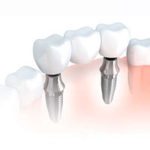
A dental bridge is used when a missing tooth must be replaced as a missing tooth can cause a variety of problems and affect the appearance of your smile.
A dental bridge is used when a missing tooth must be replaced as a missing tooth can cause a variety of problems and affect the appearance of your smile. Missing teeth can result in a change in bite, shifting of the teeth, temporomandibular joint disorder (TMJ), speech impediments, an increased risk of periodontal disease, and an increased risk of tooth decay. A dental bridge is a partial denture, much like a dental implant, that is used to replace missing teeth. There are a variety of fixed dental bridges, including:
- Conventional fixed bridges
- Cantilever bridges
- Resin-bonded bridges
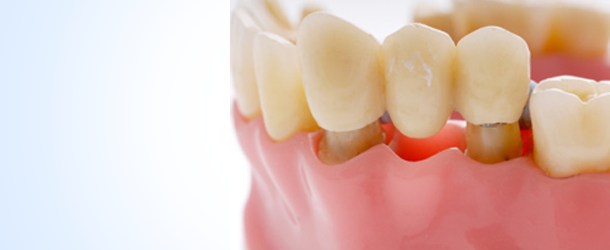
Conventional and cantilever bridges require shaping of the teeth that surround the missing tooth. A dental crown is then placed on shaped teeth and an artificial tooth is connected to them for support. This is known as a pontic.
The materials commonly used in bridges are; a combination of porcelain and metal, a combination of porcelain and gold, and high-strength-metal-free materials like alumina and zirconia. After taking x-rays and an impression of the focused area, your Denver dentist will create the ideal bridge for each patient’s situation; creating a natural-looking smile with a realistic tooth-like bridge, matching the original teeth in both shape and shade.
Dental Bridge Procedure
Dental bridges are usually performed in two visits; during the first visit, the patient’s teeth are examined. Once it is determined that they will receive a dental bridge, a local anesthetic will be given in order to prepare the teeth that will support the dental bridge. After the preparation of the teeth is complete, a mold is taken of them in order to design a dental bridge that has a natural and secure fit. Without a secure fit, the teeth under the bridge supports can suffer from decay because they are nearly impossible to clean with the bridge in place. Until the permanent bridge is completed, your dentist will fit you with a temporary dental bridge so the teeth and gums can be protected from damage. To complete the dental bridge procedure, you must return to the dental office for a second visit to have the bridge fitted and cemented in place. After the dental bridge is correctly fitted and the bite is perfect, the dentist will take further impressions to ensure that the bite is natural and does not cause any pain or discomfort during your bite. Your dentist will also ensure that the shade is the same as your natural teeth, resulting in a natural-looking smile that will boost your confidence and make you feel better about your smile. For further information please call our office today.
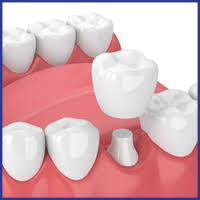
A dental crown can restore structure, strength, and function to a tooth with extensive decay or damage. They are used to cover cracked, chipped, or otherwise damaged teeth and provide a natural looking restoration that gives you a natural look and feel. Crowns are cemented into place to fully cup the portion of the damaged tooth and lie directly above the gum line.
Dental Crowns Protect Teeth and Restore Functionality
A dental crown helps to preserve the functionality of damaged teeth, protect a cracked tooth, or restore functionality of a tooth with excessive decay. A dental crown does this by encasing the tooth requiring a crown with a custom-designed material. A tooth that has extensive decay or has undergone a root canal will be a candidate for a dental crown as the damage is too extensive for veneers, direct composite bonding or other conservative treatments. A dental crown can either be use
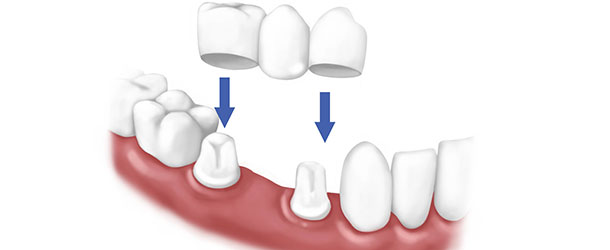
The Dental crown procedure involves the following steps:
- First, the dentist must obtain images or impressions of the tooth or teeth that are to be crowned in order to have an accurate crown made that will fit perfectly with the surrounding teeth. This is usually done in a dental laboratory, but can be performed at the dentist’s office, depending on their capabilities. A fitted temporary crown can be created during this step to temporarily protect the tooth after it has been prepared and before the actual crown is ready.
- Once the laboratory has completed the crown, it is sent back to the dentist and cemented or adhesively bonded to the tooth once the temporary crown is removed.
With the recent development of CAD/CAM dental technology, the dental crown procedure can be cut to one visit. This technology allows the dentist to obtain a 3-D image of the teeth and then create the restoration by milling a ceramic block using the data from the 3-D image. The crown is prepared while the patient is in the chair, the original tooth is prepared and the crown is put in place, all in on visit to your Denver dentist’s office. This is, however, a new technology and therefore not available at all dentist offices.
With the dental crown in place it should be treated as a normal tooth; brushing two times a day and flossing around the dental crown once a day. With a dental crown avoid chewing hard objects like fingernails. One should also avoid hard candies and foods as they can wear away the dental crown and cause a bad bite or a chip in the crown. Someone who habitually clenches or grinds their teeth may benefit from wearing a night-time mouth guard to protect the dental crown from wear.
The three most common choices for restorative materials for full coverage crowns are:
- Porcelain-fused-to-metal– A strong esthetic restorative material, over time the porcelain-fused-metal crowns may show the underlying metal at the gum line over time.
- All-ceramic (all porcelain) – The most popular restorative material today, all-ceramic uses either zirconia or aluminous materials to create natural looking crowns. As technology advances, all-ceramic materials continue to become stronger and more durable.
- Gold– As the price of gold continues to rise, the popularity of gold crowns declines, also because it is not as esthetically pleasing as other types of restoration material. They are most often used for teeth located in the back of the mouth (such as molars), because they are harder to be seen there and the durability of gold is similar to that found in molars.
Dental composite resin fillings also referred to as tooth-colored fillings, are an alternative to metal fillings. Patients who have received dental composite resin filling have natural-looking teeth and only their dentist knows that they have fillings because no one else can see them at all.

Composite resins are a silicon dioxide-filled, tooth-colored, plastic mixture that can restore teeth to a healthy, natural white state. Composite resins offer several advantages over traditional silver or amalgam fillings:
- They are better refined than gold and amalgam– resulting in more accurate replication of a natural tooth’s function
- They are not made of metal– a blend can be created to tailor the shade of white to match the natural color of the dental patient’s teeth.
- The bond between the tooth and the composite resin is beneficial to the remaining tooth structure– it supports the remaining tooth structure, helping to prevent breakage and also helping to relieve temperature sensitivity.
- Medium to small dental composite resins can last from seven to ten years.
- With dental composite resins more of the original tooth is saved
Dental composite resins are actually glued into the teeth, strengthening the tooth’s structure and durability. An acid etching reaction with the dental composite resin and a tooth, results in a micromechanical bond, creating a strong adhesion. The acid-etch adhesion also prevents micro leakage, but eventually all white fillings will leak slightly. This results in minimal loss of healthy tooth, when compared to silver filling because there is no need for the creation of retentive features, which destroys healthy teeth. Another good feature of dental composite resin is that it creates an extremely high bond strength to dentin and enamel, which makes it a more reliable filling material.
There are, however, disadvantages to Dental Composite resins:
- They are technique-sensitive – if they are not created and placed with attention to detail and the correct placement is not verified, they can fail prematurely.
- The time it takes to place dental composite resins far exceeds that of amalgam fillings- it can take up to 50% longer to place a composite resin filling.
- They are more expensive than amalgam fillings.
- When placed in posterior teeth they last a shorter amount of time than amalgam fillings on average.
Created as an alternative to traditional metal dental fillings, composite resin fillings offer advantages and disadvantages when chosen over metal fillings. The decision ultimately comes down to what the best decision for the patient is and Dr. Radz will help in making this decision easy. For more information please contact us today!
Replacing a Missing Tooth with a Dental Implant
A dental implant is used to replace a missing tooth by utilizing an artificial root. This artificial root is used to support a dental restoration, such as a crown, in order to prevent jaw bone loss or other dental health issues caused by a missing tooth or teeth. Categorized as a form of prosthetic dentistry, a dental implant can help to make someone feel less self-conscious.
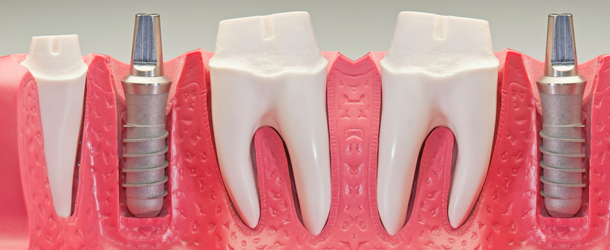
Importance of Replacing Missing teeth
There are several issues that can arise from a missing tooth or teeth. Aside from feeling self-conscious about how you look, a missing tooth or teeth can cause biting irregularities, which can, in turn, have a negative effect on how and what you eat. This can cause malnutrition, which can also lead to more dental health issues. When a missing tooth root is replaced, strength and stability are returned to the jaw bone and surrounding teeth, making chewing and eating easier. A missing tooth can also affect facial features from a loss in jaw bone integrity, so getting a dental implant can help to prevent this from happening and ensure that you maintain your original facial features.
Dental Implant Procedure
The duration of the treatment depends on the condition of the patients oral health; some patients may not require any extra work, while patients with insufficient bone or gum tissue may require the use of bone or gum tissue grafts or the use of a smaller diameter implant known as a mini implant. This causes the need for more dental visits to complete the dental implant procedure. Whether or not the patient will require sedation or anesthetics also depends on the condition of the patient. During the consultation, the dentist will go over your options and create the ideal plan for your treatment.
Overall, the dental implant procedure results in a tooth that is virtually impossible to distinguish from a natural tooth with the naked eye. This is in part due to the connection between the dental implant and the living bone of the jaw. A dental implant can be done on anyone after adolescence or when bone growth is complete, making it a very popular technique for the replacement of a missing tooth or teeth.
The first step is preparing the jaw for implantation. This is done by drilling a small hole, called a pilot hole, at edentulous jaw sites (a site on the jaw where there are no teeth) in order to guide the first part of a dental implant (a titanium screw) and hold it in place. Because the jaw bone has so many nerves that run through it, x-rays need to be taken and careful consideration is required when deciding the placement of the pilot hole. Drilling a pilot hole in the wrong place could sever a nerve resulting in lifelong consequences for the patient. After careful placement of the pilot hole, it is carefully and slowly widened until it reaches the desired diameter in order to properly support the implant screw, much like a carpenter would do with a screw hole in wood. Once the screw is securely in place the gum tissue is secured over the implant, which will eventually heal into place and protect the base of the screw. Next, a protective cover screw is placed on top to allow the site to heal and to make sure the bone accepts the screw as if it were a natural tooth root. This is essential if the implant is going to properly function. In order for the next step to take place, a dentist will usually allow up to six months of healing to ensure the implant will function properly.
After this time period, the dentist will uncover the implant and attach an abutment to the implant which will eventually hold the crown in place. Once in place, the abutment will secure a temporary crown until the permanent crown is ready. Once the permanent crown or tooth-like replacement is in place, the procedure is complete, resulting in a natural-looking replacement for a missing tooth.
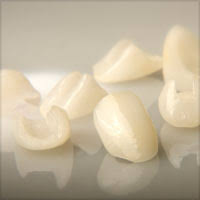
A more conservative option to dental crowns, inlays and onlays fit into a tooth similarly to a filling, yet they are milled restorations, much like a crown. An inlay is done when the tooth structure is within the cusps of the tooth. For more extensive damage such as that which covers the entire chewing surface an onlay is used.
Inlays and Onlays: A Good Alternative to Dental Crowns
Inlays and onlays are dental restorations that are a good alternative to full coverage crowns. Inlays and onlays are also known as indirect fillings that offer a longer lasting, better fitting, reparative solution to tooth decay, beneficial both esthetically and functionally. Although inlays and onlays are an alternative to traditional dental fillings, the two are extremely different:
- Traditional Dental Fillings- are molded into place within the mouth during a dental visit until the desired bite and a natural shape is achieved.
- Inlays and Onlays– are fabricated indirectly in a dental lab and then fitted and bonded during a second dental appointment.
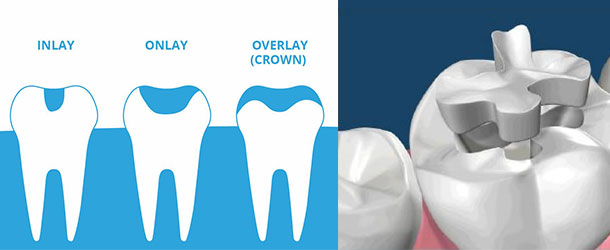
Distinguishing from an inlay and an onlay depends on the placement of the material; the restoration is called an “inlay” when the material is placed within the center of a tooth and it is called an “onlay” when the extent of the damage requires full coverage of the biting surface.
There are several benefits of inlays and onlays that are often the deciding factor in choosing them over traditional dental fillings:
- They provide a superior fit by preserving a much healthy tooth as possible.
- They are not likely to discolor over-time.
- They preserve the maximum amount of healthy tooth structure and restore decayed or damaged areas.
- They are easier than full coverage restorative alternatives such as dental crowns.
- They are better at sealing teeth to keep out bacteria.
- They are extremely stable for the treatment of decay and can actually strengthen a damaged tooth.
An inlay or onlay procedure usually takes two dental visits in order to complete; during the first visit, your dentist will prepare the damaged tooth for restoration and a molded impression of the tooth will then be taken and sent in to a dental laboratory where the inlay or onlay will be fabricated. Your Denver dentist can create a temporary inlay or onlay at this time to protect the tooth while the permanent inlay or onlay is being fabricated. During the second visit to the dentist’s office, the temporary inlay or onlay is removed and the permanent one is applied and bonded to the prepared tooth.
Inlays and Onlays can be made from three materials:
- Gold– best if esthetics is not a concern (with back molars or teeth not visible when talking or smiling).
- Porcelain-offer the best esthetics and are often used on teeth visible during a smile.
- Resin Materials– best for people who grind their teeth or those with misaligned bites.
To learn more about the restorative treatments we provide or to schedule an appointment, please contact us today! Contact our office today.
